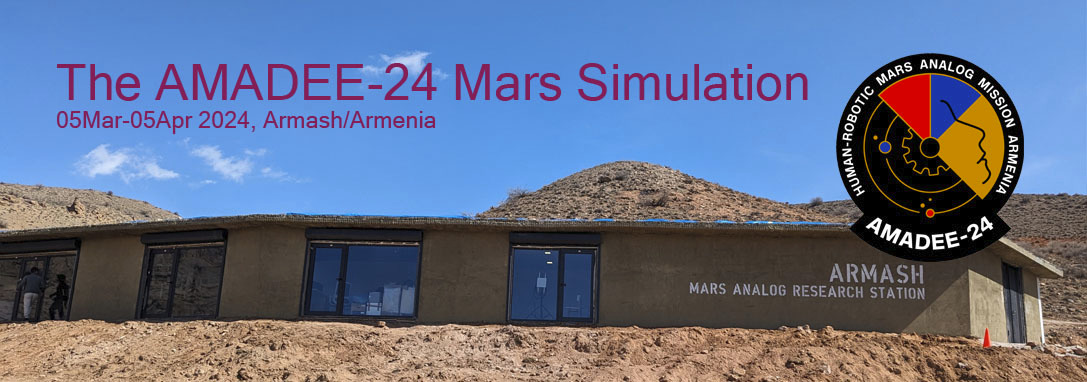AMADEE-24

Mission Information
AMADEE-24 is a Mars analogue simulation in Ararat, Armenia, managed by the Austrian Space Forum and hosted by the Armenian Aerospace Agency taking place between March and April 2024.
Simulating Mars Human-robotic surface activities in terrestrial analogues has evolved into an efficient tool for developing exploration mission architectures. They facilitate the understanding of the advantages and limitations of future Human planetary missions, becoming an added value for the development of remote science operations, helping to understand the constraints and opportunities of the technology and work-flows.
The test sites will be selected for their geological and topographic similarity to Mars. The AMADEE-24 mission presents an excellent opportunity to:
- Study equipment behaviour involving the simultaneous usage of instruments with the option of humans-in-the-loop (via two high-fidelity spacesuit simulators, portable system, etc.)
- The development of platforms for testing life-detection or geo-science techniques, robotic support tools for human missions and concepts for high situational awareness of remote support teams.
- Study the analogue as a model region for their Martian counterparts.
- Serving as a catalyst to increase the visibility of planetary sciences and human exploration.
- Evolving the know-how of managing human missions to Mars deploying a realistic model for Mission Support centre – Astronaut actions and the encompassing decision making framework.
End of Mission
The Mission was succesfully conducted and ended on the 08 Apr 2024. As one of the main output documents we are proud to present the Mission Report to all of you. Please find the Report by clicking on the link below.
Also check out our photo archive:
Experiments:
| Name | Description | Organisation | |
|---|---|---|---|
| ALIX | Radio interferometry-based location tracking using room-scale antenna setups to investigate cm-scale tracking, as well as ground receiver stations for km-resolution. | Radboud University, The Netherlands Eindhoven Univ.of Technology, NL | |
| AVAWT | Powergeneration and measurement of wind velocitywith awind turbine.Testing a structural improvementto the turbine to increase the efficiency. Cancelled | Bazoomq Space Research Laboratory, Armenia | |
| Emotions in Extrem Environments | AAintrinsic/extrinsic emotion regulationstrategies, using CERQ questionnaire +audio recordings, emotion listing andlogbook in the evening. | ÖWF / Human Factors, Austria Bielefeld University, Germany | |
| FaR SiDE | Biomech model verification of estimations of skeletal muscular and cardiovascular fatigue, using motion capture, force sensors, EMG/ECG, NIR, spirometry. | ÖWF / Aouda, Austria Institute of Mechatronics University of Innsbruck, Austria | |
| GENES4MARS | Astronaut performance and health monitoring with automated ECG andinvestigation of the changes in health-risk-associated gene expression patterns in blood and urine samples of astronauts. | Institute of Biomedicine and Pharmacy Russian-Armenian University Institute of Molecular Biology NAS RA, Armenia | |
| GeoPrep | Geo-sampling selection and curation within habitat; performing a petrological analysis with simple tools (incl. cutting / polishing samples), microscopy optical/Raman/IR; post mission lab analysis. | Institute of Geology, Mineralogy and Petrology University of Innsbruck, Austria | |
| GEOS-24 | Application of the Exploration Cascade & Sampling strategy, geomapping & IR/RAMAN spectroscopy | Austrian Space Forum, Austria | |
| Hort3Space | An automated multilevel cultivation prototype, equipped with cultivation specific full spectrum LED lights placed inside a sterile grow room in an inflatable self-erecting tent to evaluate cultivation performances, supporting the diet of the crew | ENEA Biotechnology Laboratory, Casaccia Research Center, Italy BIOAG (Biotechnology and Agroindustry Division) La Sapienza University of Rome DIMA (Department of Mechanical and Aerospace Engineering), Italy | |
| HUMANISE | Teleoperations comparison using brain computer interaction, augmented reality,and gamepad for comparison to reduce overall mission workload on astronauts. Cancelled | Delft University of TechnologyLunar Zebro team, The Netherlands Institute for Environmental Physiology Masaryk University, Kamenice, CZ ISAE SUPAERO,University of Toulouse, France | |
| IAQHabitat | Habitat indoor air quality measurement. | Fraunhofer WKI | |
| iROCS | Robotic scene-understanding/obstacle evaluation, sample collection and identification, semantic mapping and terrain modeling in desert environments with mobile, spherical robots or with handheld devices. | Forschungs & Entwicklungs GmbH FH Upper Austria, Austria Julius-Maximilians-University Würzburg, Germany University of Applied Sciences Würzburg-Schweinfurt, Germany | |
| MEROP | Human-robotic multimodal teleoperation interface for AA teleoperations and MSC t/m visualization; this shall allow AA's to switch between semi-autonomous teleoperation and direct control. | Instituto Superior Técnico University of Lisbon, Portuga | |
| PRESSURE | Crew stress simulation -emergency situation (technical/medical type) where teams will have to organize and execute a rescue operation during an EVA. The emergency scenario will consist of a combined technical and not serious medical condition.The technical problem will be simulated by time constrained problem-solving tasks. | Neuropsychology and Experimental Psychology Lab University of Cádiz, Spain | |
| RAMSES | Fully autonomous multi-sensor-based helicopter system capable of taking off from a charging dock atop a Mars rover, then conducting aerial reconnaissance for operator-requested POI inspection or autonomous terrain mapping before landing back on the rover to recharge. | University of Klagenfurt, Austria Institute for Production Science University of Technology,Graz, AT Joanneum Research,Graz, Austria | |
| SAMPLE | Rover traversability, teleoperations for sample acquisition and transport to Hab using semi-autonomous traverse finding rover. | Institute of Software Technology Institute of Geodesy University of Technology Graz, AT | |
| Staying Alive! | A photobioreactor as the air revitalization component of the Hab life support system, equipped with a situationally aware and interactive sensor network. The study also assesses the psychological impact, reactor control from Earth and crew interfacing. | ZARM -Center of Applied Space Technology and Microgravity, University of Bremen, Germany |